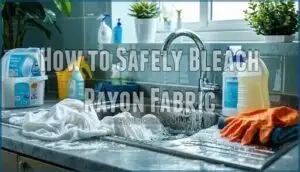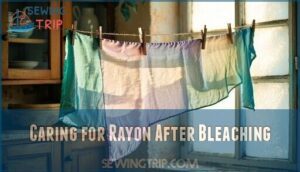This site is supported by our readers. We may earn a commission, at no cost to you, if you purchase through links.
 Rayon fabric bleaches differently than you might expect—black rarely becomes white, and that navy dress could emerge from a bleach bath as peachy-orange instead. This semi-synthetic fiber shares cotton’s cellulose structure, which means bleach penetrates the fibers readily, but rayon’s weaker construction makes the process a balancing act between color removal and fabric integrity.
Rayon fabric bleaches differently than you might expect—black rarely becomes white, and that navy dress could emerge from a bleach bath as peachy-orange instead. This semi-synthetic fiber shares cotton’s cellulose structure, which means bleach penetrates the fibers readily, but rayon’s weaker construction makes the process a balancing act between color removal and fabric integrity.
The unpredictability stems from how manufacturers dye rayon: some pigments strip away cleanly while others cling stubbornly or reveal hidden undertones. If you’re ready to transform a rayon garment or salvage a stained piece, understanding the right bleaching technique prevents disappointment and fabric damage.
The process requires specific safety gear, careful dilution ratios, and close monitoring—but with proper preparation, you can achieve striking results while keeping the fabric intact.
Table Of Contents
Key Takeaways
- Rayon bleaches unpredictably—black fabric rarely turns white and often shifts to orange, pink, or yellow instead because dyes decompose unevenly and reveal hidden undertones beneath the surface color.
- Chlorine bleach works fast (15-30 minutes) but weakens rayon fibers by up to 18% with repeated use, while oxygen bleach takes longer (60-90 minutes) but causes less than 5% structural damage.
- Success depends on three critical controls: dilution ratios between 1:1 and 1:5 (bleach to water), monitoring color changes every 30 seconds during the first two minutes, and immediately neutralizing with vinegar to stop the chemical reaction before it destroys the fabric.
- Bleached rayon requires permanent care changes—cold water washing only, air-drying flat, no fabric softener, and storage away from sunlight to preserve both the altered color and weakened fiber structure.
Will Rayon Fabric Bleach Successfully?
Rayon sits in an interesting middle ground regarding bleaching—it’s a natural fiber that responds well to bleach, but the results won’t always be what you expect.
Understanding how rayon reacts compared to other fabrics helps you anticipate what’ll happen when you apply bleach. Here’s what you need to know about rayon’s bleaching potential and how it stacks up against other materials.
Rayon’s Fiber Structure and Bleach Response
Rayon might look delicate, but its semi-synthetic structure—made from regenerated cellulose fibers—actually interacts with bleach in ways that can surprise you. The fiber composition allows bleach penetration similarly to cotton, making rayon suitable for the bleaching process.
However, textile science shows that rayon’s weaker fiber properties mean the bleach solution can cause fabric degradation if you’re not careful. You’ll often see dramatic color shifts during bleach application—sometimes revealing unexpected hues beneath the surface dye.
Comparison With Other Fabrics (Cotton, Polyester, Etc.)
When comparing fabric durability and bleach resistance, cotton stands out as the most forgiving. It manages bleach well with predictable color fastness changes. Polyester, on the other hand, resists bleaching entirely—the synthetic fibers stay colorfast no matter how long you soak them.
Rayon sits between these extremes: it bleaches like cotton but weakens faster, demanding closer attention during fabric bleaching techniques to prevent damage.
Understanding the differences in rayon vs cotton is essential for making informed decisions about fabric care and selection.
Common Color Changes in Rayon
Once you understand how rayon reacts to bleach, the next surprise is seeing what colors emerge—black rarely turns white, and dark shades often shift to unexpected oranges, pinks, or yellows instead.
These color shifts happen because dye removal doesn’t work uniformly—fiber reactions depend on the original dye formulation. Bleach effects reveal underlying pigments, making fabric bleaching unpredictable but exciting for creative projects.
How to Safely Bleach Rayon Fabric
Bleaching rayon isn’t something you want to wing—it requires the right approach to avoid damaging your fabric or putting yourself at risk. Before you start experimenting with color removal, you need to understand what you’re working with and how to manage it properly.
Let’s cover the three essential foundations that’ll set you up for success.
Essential Safety Precautions and Gear
Before you pour a single drop of bleach on your rayon, you need to treat it like the chemical reaction it is—one that demands respect, preparation, and the right protective gear. Wear chemical-resistant gloves, safety goggles, and protective clothing that covers your skin.
Work in a well-ventilated space—open windows or use ventilation systems to avoid inhaling fumes from bleaching agents. Keep a first aid kit nearby, and never mix bleach with other cleaners.
Choosing The Right Bleach (Chlorine Vs. Oxygen)
You’re not just picking a bleach—you’re choosing between speed and safety. Chlorine bleach strips color fast, removing dye from rayon in 15–30 minutes, but its pH of 11–13 can weaken fibers by up to 18% after repeated use.
Oxygen bleach (hydrogen peroxide or sodium percarbonate) works gentler at pH 8–10, taking 60–90 minutes but preserving fabric strength with less than 5% fiber damage across multiple treatments.
When considering the environmental impact, it’s vital to understand oxygen bleach benefits.
Performing a Spot Test
A hidden seam or inconspicuous hem is your testing ground—skip this step, and you risk turning a salvageable project into a cautionary tale. Apply diluted bleach to test strips and wait 10 minutes to check material reaction and color fastness. This reveals whether your rayon will bleach evenly or surprise you with orange undertones.
- Use a 1:4 bleach concentration for safe fabric sampling without immediate fiber damage
- Select hidden areas like inner seams where bleach application won’t show if results disappoint
- Document timing and color shifts to replicate successful bleaching rayon threads across your entire project
Step-by-Step Guide to Bleaching Rayon
Now that you’ve gathered your materials and tested your fabric, it’s time to walk through the actual bleaching process. Each step builds on the last, taking you from preparation through final neutralization.
Follow these stages carefully to achieve the results you’re after while keeping your rayon intact.
Preparing The Fabric and Workspace
Setting up your workspace correctly can mean the difference between a controlled, artistic bleach job and a chaotic mess that ruins both your fabric and your countertop.
Start with fabric inspection—check your rayon for stains or weak spots that could worsen during fabric treatment. Cover your work surface with plastic sheeting or old towels, and sort materials by color intensity.
Verify proper ventilation before managing bleach, and gather safety measures like gloves and eye protection within arm’s reach.
Mixing and Diluting Bleach Properly
The ratio of bleach to water isn’t just a measurement—it’s the control dial that determines whether your rayon transforms beautifully or falls apart in your hands. Start conservative with dilution ratios that protect your fabric while delivering results.
- 1:1 ratio (bleach to water) creates maximum bleach strength for stubborn dyes, but increases fabric stress
- 1:3 ratio balances bleach concentration with safety measures for controlled color removal
- 1:5 ratio offers gentle bleaching action, ideal for delicate rayon or subtle effects
- Neutralization techniques require a vinegar rinse (1 cup per gallon of water) immediately after bleaching
- Colorsafe bleach alternatives won’t work on rayon—stick with standard bleaching agents for actual results
Applying Bleach (Soak, Spray, or Direct)
Your application method isn’t just about getting bleach onto fabric—it’s the difference between intentional artistry and a laundry disaster. Each approach demands proper fabric preparation and understanding of soak times to prevent damage while achieving your vision.
Soaking submerges rayon completely in diluted bleaching agents for uniform color removal across large pieces.
Spray techniques let you control bleach concentration in specific areas, creating gradients and patterns.
Direct application with brushes or pouring delivers bold, unpredictable designs.
Monitoring Color Change and Timing
Once bleach hits rayon, timing becomes everything—walk away too long and you’ll dissolve the fabric, pull it too soon and you’ve wasted your effort on barely-there results. Watch color shift patterns continuously during bleach application—dye removal rates accelerate as the solution penetrates deeper into fibers.
Master shade control methods through fabric monitoring:
- Check every 30 seconds during the first two minutes when color discharge happens fastest
- Look for undertones emerging beneath surface dyes—orange or pink signals you’re close to maximum lightening
- Stop before your target shade because bleach timing continues affecting color removal even after initial application
Pull your rayon when it’s slightly darker than desired—the chemical reaction keeps working until you neutralize it.
Rinsing and Neutralizing The Fabric
Right after you spot that undertone shift, cold water becomes your emergency brake—it shuts down the chemical reaction before bleach eats through rayon’s delicate cellulose structure. Flush thoroughly for a minimum of three minutes, then neutralize with white vinegar or hydrogen peroxide to restore the fabric’s pH balance and halt bleach residue removal.
Rinse water temperature matters—hot water reactivates bleach, damaging fibers you just saved.
| Neutralizing Agent | Application Method | Post Bleach Soaking Time |
|---|---|---|
| White Vinegar (1:4) | Submerge completely | 5-10 minutes |
| Hydrogen Peroxide (3%) | Spray or soak | 3-5 minutes |
| Baking Soda Solution | Gentle agitation soak | 5 minutes |
| Cold Rinse Water | Running water flush | Until clear (3+ minutes) |
Troubleshooting Rayon Bleaching Issues
Not every bleaching attempt goes as planned, and rayon can throw some curveballs. You might end up with unexpected colors, uneven patches, or fabric that won’t budge at all.
Here’s how to troubleshoot the most common problems and get back on track.
Unexpected Color Outcomes (Orange, Pink, Etc.)
Sometimes rayon surprises you—bleach doesn’t always deliver white. Chemical reactions between bleach and dye molecules trigger unexpected color shifts. Instead of clean whites, you might see orange, pink, or even reddish tones emerge.
These color outcomes happen when reactive dyes decompose into colored byproducts, or when fabric impurities like metallic ions interact with bleach, forming new colored complexes that resist complete color removal.
Dealing With Uneven or Blotchy Results
Uneven patches and streaky marks show up when bleach hits fabric inconsistently—but you can fix most of these problems with the right approach. Blotchy results stem from uneven bleach application or inconsistent fabric texture that affects bleach penetration rates.
Control your technique with these critical fixes:
- Apply bleach methodically—spray from consistent distances or submerge completely to guarantee uniform color removal across all fibers
- Adjust bleach concentration—dilute stronger solutions to slow reactions and prevent rapid color variation in high-contact zones
- Neutralize immediately after achieving desired results—stopping the chemical reaction prevents further uneven bleaching and preserves fabric integrity
What to Do if Rayon Doesn’t Bleach
Some rayon pieces stubbornly resist bleach no matter how long you wait—and that’s when you need to switch tactics entirely. Check for synthetic fiber blending or protective coatings through fabric analysis before wasting more bleach. Consider these alternatives:
| Issue | Cause | Solution |
|---|---|---|
| No color removal | Polyester blend present | Try reductive bleaching agents like Thiox |
| Colorfast dye | Chemical dye enhancement treatment | Overdye for color correction instead |
| Protective coating | Manufacturing finish blocks bleach penetration | Strip coating, then retry neutralization process |
| Wrong bleaching agents | Oxygen bleach used instead | Switch to chlorine bleach for rayon |
| Synthetic rayon | Non-natural fiber composition | Accept limitation; explore fabric painting |
Caring for Rayon After Bleaching
Once you’ve bleached your rayon, the real work begins—keeping that fabric in good shape takes more than tossing it in the wash. Bleach weakens fibers and changes how the material reacts to water, heat, and even dye.
Here’s how to manage your freshly bleached rayon so it stays wearable and vibrant for the long haul.
Gentle Washing and Drying Tips
After bleaching strips color from rayon, your fabric needs a gentler touch than ever—think of it as nursing freshly dyed hair back to health. Here’s how to protect your transformed textile:
- Choose gentle cycles with cold water—heat accelerates fiber breakdown and threatens color preservation
- Skip fabric softening and detergent additive impacts that coat fibers and dull your hard-won results
- Air-dry flat or use low-heat drying techniques to prevent shrinkage and maintain structural integrity
- Store in folded storage away from direct sunlight to preserve your bleach alternatives’ effects and extend fabric life
Bleaching Effects on Rayon Threads
Embroidery enthusiasts, take note: bleaching effects on rayon threads differ dramatically from those on the base fabric. While rayon fabric accepts bleach reasonably well, rayon threads face serious degradation. Chlorine bleach strips tensile strength by 25% after repeated exposure, causing fiber breakage and fabric damage. Even color-safe varieties trigger color shifts—black threads turn orange or pink rather than white. Bleach resistance is practically nonexistent in rayon thread due to its hydrophilic fiber properties, which accelerate chemical penetration.
Manufacturers universally recommend against bleaching rayon embroidery threads—the bleaching effects compromise both appearance and durability permanently.
| Bleach Type | Thread Care Impact | Risk Level |
|---|---|---|
| Chlorine Bleach | Severe strength loss, color shift | High |
| Oxygen Bleach | Moderate fading, bleeding | Medium-High |
| Color-Safe Bleach | Uneven color shift, bleeding | Medium |
Overdyeing and Creative Finishing Options
Transform your bleached rayon into a canvas of possibility—overdyeing lets you layer fresh colors onto faded fabric, turning experimental pieces into intentional masterpieces. Bleach acts as your first step in color removal and discharge, creating a foundation for dyeing techniques that pop with vibrancy.
- Tie dye patterns gain intensity on pre-bleached backgrounds
- Shibori folding creates dimensional contrast when overdyeing bleached sections
- Resist techniques protect selected areas during the fabric dyeing process
- Natural dyes like indigo produce earthy tones on discharged rayon
- Fabric painting adds precise detail to your bleach-altered textile
Long-Term Fabric Care and Maintenance
Your bleached rayon will last for years if you treat it with the respect it earned through every careful rinse and color shift.
Fabric storage away from direct sunlight prevents fading, while cold water washing maintains thread durability and shrinkage control. Skip fabric softening—it coats fibers and dulls your hard-won results.
| Laundry Tips | Fabric Care Strategy |
|---|---|
| Color Preservation | Wash in cold water, air dry flat |
| Thread Durability | Avoid harsh detergents and bleach application |
| Fabric Treatment | Store folded in cool, dark spaces |
Frequently Asked Questions (FAQs)
Is it safe to bleach rayon fabric?
Yes, you can safely bleach rayon fabric with proper precautions. Use diluted bleach, work in a well-ventilated area, wear protective gear, and neutralize the fabric immediately after to prevent damage and maintain color stability.
Can I use chlorine bleach on rayon?
Chlorine bleach works on rayon, but proceed carefully. This powerful agent removes color effectively from rayon’s cellulose-based fibers.
However, chlorine risks weakening fabric structure and causing unexpected color shifts—think orange or pink instead of white. Always dilute bleach and test first.
What are the potential risks of bleaching rayon fabric?
Bleach poses serious threats to rayon: fiber degradation weakens the material, shrinkage distorts dimensions, and thread breakage ruins structural integrity.
Color loss may be unpredictable, turning black fabric orange or brown pink.
Fabric damage increases with prolonged bleach application and safety.
Are there any specific precautions I should take when bleaching rayon?
When tackling fabric bleaching, think of it as controlled demolition—precision matters. Always dilute your bleach concentration to prevent severe fiber damage and fabric weakening.
Bleaching rayon demands precision—dilute carefully to avoid severe fiber damage and fabric weakening
Test a hidden spot first to anticipate color shifts. Work in a ventilated space, wear gloves, and neutralize thoroughly after bleach application to protect rayon’s delicate structure.
Are there any alternative methods to bleach rayon fabric?
Try discharge methods like Thiox or Sodium Hydrosulfite for cleaner results. Natural dyes, optical brighteners, and fiber blending offer gentler alternatives.
Overdyeing bleached rayon creates new patterns without harsh chemicals. Test thread alternatives before committing to full-scale fabric dyeing projects.
Can rayon be bleached with household products?
Household chlorine bleach works perfectly for rayon. You can dilute it with water for controlled color removal.
Hydrogen peroxide and sodium carbonate (washing soda) offer gentler alternatives, though they work slower and produce subtler results than standard bleach.
How long does bleaching rayon typically take?
Timing varies widely—from five minutes to two hours—depending on bleach concentration, fabric thickness, rayon weave, and color depth. Darker fabrics take longer than lighter ones.
Monitor closely since bleaching speeds up as it progresses.
Does bleach weaken or damage rayon fabric?
Like a double-edged sword, bleach removes color effectively but compromises rayon’s fiber strength and material durability. Chlorine bleach degrades cellulose fibers, reducing fabric longevity.
While rayon lacks bleach resistance, proper dilution and timing minimize structural damage during fabric dyeing and bleaching processes.
Can you bleach rayon clothing with prints?
Printed rayon fabric can be bleached, but results vary wildly. The base fabric may lighten while prints often resist bleach or fade unpredictably due to colorfast dyes or synthetic ink formulations.
Always spot-test first—dye bleeding and partial print removal are common.
Is it safe to bleach rayon blends?
It depends on the blend composition. Rayon blends with natural fibers like cotton bleach reliably, while polyester or nylon blends resist color removal and may suffer fabric durability issues, requiring careful spot testing first.
Conclusion
Bleaching rayon is like walking a tightrope—precision keeps you balanced between transformation and disaster. When you know how to bleach rayon fabric properly, you reveal creative possibilities without sacrificing durability.
Remember: test first, dilute carefully, and watch closely. The fabric won’t always land where you expect, but that unpredictability becomes part of the craft.
Your patience determines whether you’ll celebrate a successful refresh or mourn a ruined garment. Master the process, and rayon becomes your canvas.














